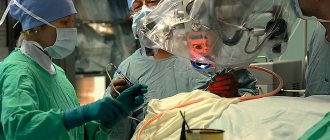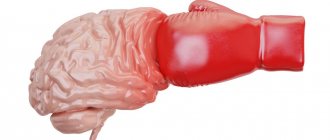How long do you stay in hospital after a stroke?
Saratov State Medical University named after.
IN AND. Razumovsky (SSMU, media) Level of education - Specialist
1990 - Ryazan Medical Institute named after Academician I.P. Pavlova
The length of time a patient will need to undergo treatment in a hospital setting after a stroke has occurred directly depends on the severity and subsequent dynamics of the disease. There is little point in keeping someone in a hospital ward for too long after a stroke, since everything is determined by the first hours and days, as well as how well the patient’s condition then improves. If the situation is stabilized and there is no need to put in IVs, then the patient can be discharged in a few weeks. Therefore, everything will depend on the person’s condition and what plan he had for the stroke.
Caring for patients after a stroke: caring for a bedridden patient at home and in the hospital
Caring for patients after a stroke is the key to improving their quality of life and speedy recovery. A stroke patient requires constant care. The simplest manipulations become a problem for him - personal hygiene, food consumption, movements are not easy. This short guide will help you get comfortable with caring for the sick.
The patient's arms need to be bent and unbent at each joint several times, and the patient's fingers must be straightened and bent. Rotational movements can also be made in the shoulder and wrist joints. Classes are accompanied by a light massage throughout the entire limb.
About the timing and stages of treatment for stroke in an inpatient setting
Nowadays, stroke has become a fairly common disease. On average, 3-4 people have seizures per 1000 people. Most of the cases are patients suffering from ischemic stroke, others are people with the hemorrhagic type of the disease. All relatives are always interested in the question of how much time the victim needs to spend in intensive care and in the hospital for the condition to completely stabilize.
How long you stay in the hospital after a stroke will depend on how each stage of the disease progresses. Namely:
- Period before hospitalization;
- Treatment in the intensive care unit, as well as in the intensive care unit;
- Inpatient placement in a general ward.
How long a patient will have to stay in hospital after a stroke is regulated by the Ministry of Health based on established standards of treatment.
Average length of treatment for stroke in hospital
Currently, the prevalence of stroke is 3-4 cases per 1000 people in Russia, with the majority being patients with ischemic stroke - about 80% of cases, the remaining 20% are patients with the hemorrhagic type of the disease.
For relatives and friends of the victim, an attack of acute cerebrovascular accident is often a surprise, and an important question that worries them is the question of how long they stay in intensive care after a stroke and how long the treatment in the hospital lasts in general.
Treatment of stroke consists of several stages
All treatment of acute cerebrovascular accident consists of several stages:
- Pre-hospital stage.
- Treatment in the intensive care unit.
- Treatment in a general ward.
The question of the number of days of hospital stay for a stroke is regulated by treatment standards developed by the Ministry of Health.
The duration of stay of patients in hospital conditions is 21 days for patients without impairment of vital functions and 30 days for patients with serious impairments.
If this period is not enough, a medical and social examination is carried out, where the issue of further treatment according to an individual rehabilitation program is considered.
As a rule, patients stay in the intensive care unit for no more than three weeks after a stroke. During these periods, specialists try to prevent serious complications, which for the most part arise due to defective brain function, so strict monitoring of the patient’s vital signs is carried out.
All patients who have signs of cerebral ischemia or hemorrhagic stroke are subject to hospitalization. The length of time a patient is kept in the intensive care unit is always individual and depends on many factors:
- Localization of the lesion and its size - with a major stroke, the period of stay in intensive care is always longer.
- The severity of clinical symptoms of the disease.
- The level of depression of the patient's consciousness - if the patient is in a coma, transfer to the general ward is impossible; he will be in the intensive care unit until his condition changes in a positive direction.
- Inhibition of the basic vital functions of the body.
- The need for constant monitoring of blood pressure levels due to the threat of recurrent stroke.
- The presence of serious concomitant diseases.
Treatment after a stroke in the intensive care unit of a hospital is aimed at eliminating violations of the vital functions of the body and consists of undifferentiated, or basic, and differentiated, depending on the type of violation.
Stroke therapy should be early and comprehensive
Basic therapy includes:
- Correction of breathing disorders.
- Maintaining hemodynamics at an optimal level.
- Combating cerebral edema, hyperthermia, vomiting and psychomotor agitation.
- Patient nutrition and care activities.
Differentiated therapy varies depending on the nature of the stroke:
- After a hemorrhagic stroke, the main task of specialists is to eliminate cerebral edema, as well as correct the level of intracranial and blood pressure. The possibility of surgical treatment is being determined - the operation is performed after 1-2 days in the intensive care unit.
- Treatment after an ischemic stroke is aimed at improving blood circulation in the brain, increasing tissue resistance to hypoxia and accelerating metabolic processes. Timely and correct treatment significantly reduces the length of stay in the intensive care unit.
It is quite difficult to make a forecast of how long a patient will stay in the intensive care unit after a stroke - the timing is always individual and depends on the extent of brain damage and the body’s compensatory abilities. Typically, younger people recover faster than older patients.
To transfer a patient from intensive care to a general ward, there are certain criteria:
- Stable blood pressure and heart rate levels over the course of an hour of observation.
- The ability to breathe independently without the support of devices.
- Restoration of consciousness at an acceptable level, the ability to establish contact with the patient.
- Ability to call for help if necessary.
- Exclusion of complications in the form of possible bleeding.
Only after making sure that the patient’s condition has stabilized do specialists decide to transfer him to the general ward of the hospital’s neurological department. In a hospital setting, the prescribed therapeutic measures continue and the first exercises begin to restore the lost function.
Duration of sick leave after a stroke
The doctor fills out a certificate of incapacity for work
All patients hospitalized in the neurological department of the hospital with a diagnosis of “Acute cerebrovascular accident” temporarily lose their ability to work. The duration of sick leave is always individual and depends on the volume and nature of the damage, the speed of restoration of lost skills, the presence of concomitant diseases and the effectiveness of the treatment.
https://www.youtube.com/watch?v=bdSvWkb_3jI
In the case of subarachnoid hemorrhage, as well as a minor stroke of mild severity without extensive impairment of basic functions, the treatment period is on average 3 months, while inpatient treatment takes about 21 days, the rest of the treatment is carried out on an outpatient basis. A moderate stroke requires longer treatment - about 3-4 months, while the patient is kept in the neurological department of the hospital for about 30 days. In the case of a severe stroke, with a slow recovery, the standard period of hospital stay is often not enough, therefore, to extend sick leave and confirm disability after 3-4 months of treatment, the patient is sent to undergo a medical and social examination to assign a disability group and develop an individual rehabilitation program.
After a stroke resulting from the rupture of a cerebral aneurysm, the average period of treatment for an unoperated patient in a hospital hospital is 2 months, while sick leave is issued for 3.5-4 months.
If the disease relapses, the treatment period is extended by an average of 2.5 months by decision of the medical commission.
In case of a positive prognosis and continued ability to work, sick leave can be extended to 7-8 months without being referred for a medical and social examination.
The length of time spent on sick leave depends on many factors.
Patients who have undergone surgery for a ruptured aneurysm are unable to work for at least 4 months after surgery, taking into account the rate of recovery.
The duration of treatment in the intensive care and neurological department of a hospital is always individual and depends on the general condition of the patient - patients with severe impairments, with loss of the ability to independently maintain vital functions, stay in the department much longer.
Source: https://GolovaLab.ru/insulto/kak-lechit/skolko-dnej-lezhat-s-insultom-v-reanimacii.html
Standard situations and with complications
On average, the length of a person's stay in hospital after a stroke is 21 days. This is provided that there are no failures of body systems that fall under the category of life-critical ones. Those who have been found to have serious violations are kept for 30 days.
When the established 30 days are still too short for the condition of the person being treated, a medical and social examination is scheduled to consider the question of how to continue treatment and whether an individual rehabilitation course is necessary. Doctors try to prevent a person from spending too much time in the intensive care unit with complications - the situation is usually stabilized within 3 weeks.
During this period, the patient's vital signs are checked and prognoses are made. Most often, disorders and complications occur due to inadequate functioning of the brain. When an ischemic stroke occurs and paralyzes an arm or leg, but the person can take care of himself, speech is not impaired - doctors consider spending 2 weeks in a hospital to be sufficient time.
Coma after a stroke: consequences and chances of recovery
This is due to the fact that brain cells are completely destroyed and brain functions are impaired. Further maintenance of life support becomes impractical, since due to irreversible changes, intelligence does not return even if the person wakes up. While a person is in a coma, he requires certain conditions of care and maintenance of his life support.
Often, coma has a disappointing prognosis. It is characterized by a patient’s condition in which the basic processes that support life activity are preserved, or the person experiences a state of complete lack of self-understanding.
What you need to understand after leaving hospital
Treatment after a stroke should be comprehensive. It is usually built as follows:
- The patient takes prescribed medications that improve blood circulation, as well as eliminate spasms and swelling;
- Electrical stimulation is performed;
- Physical therapy training is provided;
- Massage sessions are scheduled.
It is important that a person understands that after the end of a hospital stay due to a stroke, a number of treatment measures will be required and it does not end with discharge from the hospital. At home you will need to continue to do physical exercises, carefully monitor your blood pressure and your regimen. Alcohol and smoking will be strictly contraindicated. You need to move as much as possible, it is best to take walks in the fresh air.
What determines the length of hospitalization?
All patients with signs of ischemia affecting the brain or hemorrhagic stroke are required to be admitted to the hospital. The length of time a patient will be assigned to the department will depend primarily on the following factors:
- Size and location of the lesion - in the case of a major stroke, the length of stay in hospital will be significantly longer;
- How severe are the clinical symptoms;
- Is the patient in depressed consciousness? When the patient is in a coma, it will be impossible to transfer him to the general ward; he can be discharged from the intensive care unit only if the changes in his condition are positive;
- What is the state of the body’s key and vital functions;
- Is constant monitoring required and is there a risk of stroke recurrence?
- Whether the patient has or does not have serious concomitant diseases.
Treatment in intensive care conditions will be aimed at eliminating all disturbances in vital functions. It will be differentiated, basic or undifferentiated depending on what plan the violation occurred.
When and where does rehabilitation begin?
After an ischemic stroke has occurred, rehabilitation will be required, starting on days 4-5. But from the first hours when the patient arrives at the hospital, he will need passive gymnastics. This is not so much gymnastic exercises as it is giving the body a certain position in which the condition will stabilize and improve.
To do this, the patient’s arms and legs are positioned correctly, and the body is positioned in a special way. To do this, use bolsters or pillows, seating the patient in a semi-sitting position. Once every 2 hours, the position of the body will change. Already on the 4-5th day, the patient should begin to be turned into a lateral position. You cannot stay in one position for too long, so as not to cause stagnation, pneumonia or bedsores.
Is it possible for relatives to stay in hospital during the rehabilitation process?
It will be of great help to the patient if one of the relatives is in the room as often as possible. In this way, the relatives themselves have the opportunity to learn how to care for the patient before he is discharged, in order to alleviate possible difficulties later. After discharge home, relatives must dress the patient, feed, give medications and jointly perform the exercises necessary for recovery.
It is important to know many points, such as the fact that you should start putting on a shirt with the hand that was injured, and take it off with the healthy one. Even after hospitalization, you will need to communicate with the person on a regular basis, in a very calm and patient tone. The most intensive recovery of the patient occurs in the first 3-4 months after the stroke occurred.
Frequency of treatment
Often, the patient’s relatives believe that the course of treatment prescribed is very long and frequent. But this is due to the specific nature of the patient’s recovery process. Everything happens priority in the first months. At the same time, everything must be done to reduce the risk of a recurrent stroke.
The initial course is prescribed to be taken immediately after the stroke occurs. The subsequent course is carried out after 2-3 weeks. After which you will need to take about 3-4 more courses during the first 6-8 months. After this, a break of 2-3 months is taken and the course of treatment is repeated. The favorable time for rehabilitation should be used as efficiently as possible.
source
Is it possible to find out how long people are in the hospital with a stroke?
Any person suspected of having an acute circulatory disorder requires hospitalization. It is impossible to determine in advance how long people stay in the hospital with a stroke.
The timing and conditions of hospitalization, the time spent in intensive care, and in the general ward are influenced by many factors. Sometimes even the attending physician is unable to determine the treatment period.
Stages of therapy
in the stroke :
- period before hospitalization;
- stay in the intensive care unit;
- placement in the intensive care unit;
- being in a regular ward;
- continuation of treatment at home.
The key factor that influences which department a patient will be in after a stroke is his state of health.
For reference. The period during which a patient is kept in hospital due to circulatory disorders is determined by the standards of the Ministry of Health.
The duration of hospitalization for a stroke without risk of damage to vital functions is twenty-one days. In case of serious dysfunctions, the period is extended to thirty days.
After the period of stay in the hospital, a medical commission is assembled, a medical and social examination is carried out, which determines subsequent therapy, as well as a personal rehabilitation program.
Before hospitalization
Most often, measures taken before the patient was hospitalized are the factor that influences the victim’s future life. Prompt provision of first aid will stop the development of pathology and preserve life, motor functions, intelligence, and speech.
If signs of a stroke are detected in a person, they are placed on a hard horizontal surface and an ambulance is called. Doctors have only 6 hours left to save the victim's life. In case of severe damage, help is needed within an hour. This is the only way to preserve important functions.
The patient is removed from constrictive clothing, ties, and belts and, if necessary, is reassured. It is advisable to measure blood pressure and pulse. Drug intervention provided by non-professionals leads to a significant deterioration in the condition and prognosis of life.
Goals of inpatient treatment
For reference. Placing a person who has suffered a stroke in a hospital is carried out in order to exclude dysfunctions on which his life depends. Basic and differentiated therapy is carried out here.
The basic one is focused on stabilizing breathing, blood flow, eliminating and stopping the development of cerebral edema. If necessary, measures are taken to reduce the temperature and relieve vomiting. They give medications to help relieve anxiety. Differentiated therapy depends on the type of disease.
In case of hemorrhagic stroke, actions are aimed at relieving edema and preventing its development. Victims are given anticoagulants to prevent rebleeding. Blood pressure stabilizes. The need for surgical intervention is assessed. The operation is usually performed no later than 1-2 days from the moment of hospitalization.
If
ischemic stroke , the goal of therapy is to normalize blood circulation, improve metabolism in the neurons of the brain, weaken the signs of oxygen deficiency, and increase blood viscosity.
Reanimation
A person who has suffered a stroke is placed, first of all, in the intensive care unit. This is necessary to assess and monitor the condition, the need for surgical intervention, eliminate the risk of complications, and stabilize vital functions.
Basic and differentiated therapy
Treatment of a patient in the intensive care unit involves basic and differentiated therapy.
Basic treatment is aimed at:
- fight against cerebral edema;
- restoration of normal functioning of the respiratory system;
- patient nutrition;
- maintaining hemodynamics at an acceptable level.
Differentiated therapy involves:
- normalization of arterial and intracranial pressure, elimination of cerebral edema after hemorrhagic stroke. In the first two days, a decision is made regarding the need for surgery. Neurosurgeons at the Yusupov Hospital daily perform surgical interventions to eliminate the consequences of stroke and save the lives of hundreds of patients. All manipulations are carried out using modern medical equipment using effective proven techniques;
- accelerating metabolic processes, improving blood circulation and increasing the resistance of brain tissue to hypoxia when diagnosed with ischemic stroke. The length of stay in intensive care directly depends on the timely and adequate course of treatment.
In most cases, young people recover much faster than older patients.
It is possible to transfer a victim from the intensive care unit to a general ward after meeting a number of criteria:
- the patient can breathe independently, without the support of devices;
- the patient is able to call a nurse or doctor for help;
- there is a stable level of heart rate and blood pressure;
- the possibility of bleeding is excluded.
Factors determining length of hospitalization
It is impossible to determine how long a person will spend in the hospital. This is difficult for doctors and relatives to do.
Several factors are decisive for understanding the length of treatment for a stroke in a hospital:
- Features of damage. The volume, nature of development, and complications that have arisen are considered. An extensive, hemorrhagic stroke is an indication for a long stay in the hospital.
- Manifestation of symptoms. Signs of a stroke and their severity can destabilize the patient’s condition over a long period of time. It is not advisable to prescribe it when deterioration may occur. Lack of stability increases the likelihood of another stroke, severe consequences, or the development of complications.
- Coma . In a comatose state, the risk of deterioration of the patient's condition is high. The person is in the hospital until consciousness and key indicators normalize.
- Stabilization of functions important for the life of the body. The work of the heart, respiratory system, and the degree of damage to other organs are analyzed.
- Treatment being carried out. After complex surgery, people usually spend more time in the hospital.
- Dynamics. Before making a decision on discharge, doctors clarify how the process of stabilizing the patient is going.
- Concomitant pathologies of the cardiovascular system. A common complication after a stroke is exacerbation of heart disease. Patients are often transferred from the neurology department to the cardiology department.
For reference. Discharge from the hospital should occur only after the heart rhythm has stabilized and there are no complications.
How long do they stay in the hospital with a stroke, depending on the type of illness?
Stroke is an acute condition that occurs in every 3-4 people out of 1000. Approximately 80% of cases are due to ischemic hemorrhage. It is considered less dangerous than hemorrhagic and is not complicated by severe consequences. Many patients and relatives are interested in how long they stay in the hospital with a stroke immediately after the attack and during the recovery period.
However, there is no clear answer to this question - it all depends on the complexity of the patient’s condition, the type of stroke, the person’s age and many other factors. A comatose state, especially experienced in old age, greatly complicates treatment and rehabilitation.
How long do they stay in the intensive care unit?
- Stable pulse and blood pressure readings within an hour of diagnosis;
- Having the ability to breathe independently;
- Full awareness of the speech addressed to him, the opportunity to contact the attending physician;
- Complete exclusion of relapse.
All visitors bring a lot of bacteria and viruses on their clothes, bodies and hands. They are absolutely safe for a healthy person. But for patients in serious condition, they will cause a complex infection. Moreover, patients themselves can infect visitors.
Stages of treatment after an attack
There are 3 stages of a patient’s stay in the hospital after a stroke: pre-hospital, treatment in intensive care or intensive care, and stay in the general ward, where rehabilitation begins.
If 30 days is not enough, the hospital conducts a medical and social examination, and, if necessary, extends the length of stay in the hospital. The examination also establishes the process of individual rehabilitation of the patient.
Stay in intensive care
After a stroke, the patient is kept in the intensive care unit for no more than 3 weeks after the attack. During this period, doctors take care that serious complications do not arise due to the improper functioning of certain systems, mainly the brain. All patients are hospitalized, regardless of the form of hemorrhage. The length of stay in a clinical setting depends on the following factors:
- severity of symptoms of the disease;
- the lesion after a stroke is large or small;
- if a person is in the hospital with a stroke, and he experiences severe confusion or transition into a coma, then the length of stay in intensive care increases;
- the degree of damage to internal organs, inhibition of their functions;
- concomitant pathologies and the presence of high blood pressure, the need for its constant monitoring.
Reanimation department, intensive care
Here, stable functioning of the lungs and cardiovascular system is restored, primary measures are taken to restore adequate blood supply to the brain and prevent the most dangerous complications.
Indications for hospitalization in the intensive care unit or intensive care unit (2).
| Intensive care ward | Intensive care ward |
|
|
The duration of intensive treatment is very individual. In mild forms of the disease it can last several days, in moderate and severe forms it can last several weeks. The main criterion for a patient’s discharge is the absence of indications for further stay.
Transfer to the general ward
When transferred to a general ward of a hospital after a stroke, the patient must meet the following requirements:
- he does not need a ventilator;
- the person is conscious, he not only lies, but can move if there is no paralysis;
- the pulse is normal, and pressure drops do not occur;
- the risk of recurrent stroke is reduced.
Only if all indicators are normal does the person continue to lie in the general ward of the hospital, in the neurology department. This is where the rehabilitation period begins, which includes drug therapy and a set of therapeutic exercises.
After 3 weeks in the general ward, the patient is sent home for further outpatient treatment. If a person was working at the time of the attack, he is issued a certificate of incapacity for work. In this case, the length of sick leave depends on the type of pathology and disorders that arose against the background of a stroke.
In severe forms of stroke, a disability is often assigned, and the person is released from his usual work. A medical and social examination must establish and assign a disability group. It should be noted that patients after a rupture of an aneurysm leading to a hemorrhagic stroke remain in intensive care for at least 60 days . After this, they receive sick leave for at least 4 months.
Which department are they in with a stroke?
Stroke is an acute condition that occurs in every 3-4 people out of 1000. Approximately 80% of cases are due to ischemic hemorrhage. It is considered less dangerous than hemorrhagic and is not complicated by severe consequences. Many patients and relatives are interested in how long they stay in the hospital with a stroke immediately after the attack and during the recovery period.
However, there is no clear answer to this question - it all depends on the complexity of the patient’s condition, the type of stroke, the person’s age and many other factors. A comatose state, especially experienced in old age, greatly complicates treatment and rehabilitation.
Stages of treatment after an attack
There are 3 stages of a patient’s stay in the hospital after a stroke: pre-hospital, treatment in intensive care or intensive care, and stay in the general ward, where rehabilitation begins.
If 30 days is not enough, the hospital conducts a medical and social examination, and, if necessary, extends the length of stay in the hospital. The examination also establishes the process of individual rehabilitation of the patient.
Stay in intensive care
After a stroke, the patient is kept in the intensive care unit for no more than 3 weeks after the attack.
During this period, doctors take care that serious complications do not arise due to the improper functioning of certain systems, mainly the brain.
All patients are hospitalized, regardless of the form of hemorrhage. The length of stay in a clinical setting depends on the following factors:
- severity of symptoms of the disease;
- the lesion after a stroke is large or small;
- if a person is in the hospital with a stroke, and he experiences severe confusion or transition into a coma, then the length of stay in intensive care increases;
- the degree of damage to internal organs, inhibition of their functions;
- concomitant pathologies and the presence of high blood pressure, the need for its constant monitoring.
If the serious condition persists, the person is kept in the intensive care unit until the danger to life disappears. Basic therapy in the rehabilitation department of a hospital, where a person is admitted after a stroke, consists of the following areas:
- activities for daily care of the patient, monitoring his nutrition;
- maintaining the functioning of the respiratory system, combating any disorders;
- prevention of overheating, cerebral edema, vomiting and other pathological conditions of a person after a stroke.
If a person has suffered a hemorrhagic stroke, then the main goal of the hospital staff is to remove cerebral edema, reduce cranial pressure and normalize blood pressure. Surgical intervention may be required if, after 1-2 days in intensive care, a deterioration in health is observed.
In case of an ischemic stroke, it is necessary to improve blood circulation so that the damaged areas of the brain receive sufficient oxygen and nutrients. At the same time, metabolic processes are restored. The duration of therapy in both cases is determined by the characteristics of complications.
During the entire period, the doctor monitors the patient every day. A set of measures is used aimed at reducing complications.
Transfer to the general ward
When transferred to a general ward of a hospital after a stroke, the patient must meet the following requirements:
- he does not need a ventilator;
- the person is conscious, he not only lies, but can move if there is no paralysis;
- the pulse is normal, and pressure drops do not occur;
- the risk of recurrent stroke is reduced.
Only if all indicators are normal does the person continue to lie in the general ward of the hospital, in the neurology department. This is where the rehabilitation period begins, which includes drug therapy and a set of therapeutic exercises.
After 3 weeks in the general ward, the patient is sent home for further outpatient treatment. If a person was working at the time of the attack, he is issued a certificate of incapacity for work. In this case, the length of sick leave depends on the type of pathology and disorders that arose against the background of a stroke.
In severe forms of stroke, a disability is often assigned, and the person is released from his usual work. A medical and social examination must establish and assign a disability group. It should be noted that patients after a rupture of an aneurysm leading to a hemorrhagic stroke remain in intensive care for at least 60 days. After this, they receive sick leave for at least 4 months.
Severe stroke
How long you stay in hospital with a severe stroke, as in other cases, depends on the patient’s condition. But there is one peculiarity: if it was a hemorrhagic stroke with a rupture of an aneurysm, then after 4 months of rehabilitation the sick leave can be extended at the request of the patient without an examination (based on the opinion of the supervising doctor).
In this case, the person is constantly visited by a therapist and transmits information about his condition to the responsible medical institution. There are situations when a patient suffers a new attack of stroke and ends up back in the intensive care unit. He could receive treatment either at home or in hospital. In this case, therapy is extended without commission for another 2.5 months. A repeat course of treatment is prescribed.
In any clinical situation, the length of stay in a hospital depends on the patient’s well-being and the doctor’s information. But there is another condition in which the prognosis is the most disappointing - coma.
Unconscious sleep after stroke
Coma occurs only in 10% of cases after all strokes. A person in a coma always lies in a hospital; it is impossible to keep him at home. The duration of treatment in such a situation cannot be predicted. The person must be constantly monitored by medical personnel. This is what doctors provide if a person is in a coma after a stroke:
- strict control of vital signs provided by medical equipment: heartbeat, brain activity, blood pressure level;
- the use of anti-decubitus mattresses, as well as constant turning of the person every 3-6 hours;
- feeding through a tube with special mixtures, juices and medical nutrition in ground, heated form.
Duration of sick leave
So, sick leave is issued only when the threat to life has passed, the person has left intensive care after a stroke and has undergone a course of treatment. There is no single standard for setting deadlines. It all depends on the disorder, the amount of skills lost and the recovery process:
- in case of micro-stroke and minor violations, sick leave is issued for 3 months;
- moderate stroke is treated for at least 3 months, it can be increased without commission to 4 months;
- with a severe stroke, rehabilitation is often required for 6-8 months, and the person is given temporary disability.
If during rehabilitation, while on sick leave, a repeated relapse occurs, then treatment is extended for 2.5 months.
Adrenergic receptor blockers
Anti-stroke therapy often contains medications such as adrenergic receptor blockers. These include the following drugs:
The advantage of the above remedies is that they are not contraindicated in patients who have bronchial asthma, diabetes mellitus or significant impairment of kidney function.
The main disadvantage of andrenergic receptor blockers is their ability to influence the speed of a person's reaction.
A person taking Prazonin should carefully monitor the dosage of this drug. This is due to the fact that too much concentration of this substance can lead to a more serious decrease in pressure than expected.
Severe stroke
How long you stay in hospital with a severe stroke, as in other cases, depends on the patient’s condition. But there is one peculiarity: if it was a hemorrhagic stroke with a rupture of an aneurysm, then after 4 months of rehabilitation the sick leave can be extended at the request of the patient without an examination (based on the opinion of the supervising doctor).
In this case, the person is constantly visited by a therapist and transmits information about his condition to the responsible medical institution. There are situations where a patient suffers another stroke and ends up back in the intensive care unit . He could receive treatment either at home or in hospital. In this case, therapy is extended without commission for another 2.5 months. A repeat course of treatment is prescribed.
In any clinical situation, the length of stay in a hospital depends on the patient’s well-being and the doctor’s information. But there is another condition in which the prognosis is the most disappointing - coma.
Unconscious sleep after stroke
Coma occurs only in 10% of cases after all strokes. A person in a coma always lies in a hospital; it is impossible to keep him at home. The duration of treatment in such a situation cannot be predicted. The person must be constantly monitored by medical personnel . This is what doctors provide if a person is in a coma after a stroke:
- strict control of vital signs provided by medical equipment: heartbeat, brain activity, blood pressure level;
- the use of anti-decubitus mattresses, as well as constant turning of the person every 3-6 hours;
- feeding through a tube with special mixtures, juices and medical nutrition in ground, heated form.
What is the danger of coma after a stroke?
The average duration of a person's stay in a coma is 10-14 days, however, in medical practice, cases of many years of being in a vegetative state have been recorded.
Patient care
- The swallowing function returns (weakly expressed), the skin and muscles react to external manifestations. A person reflexively moves his limbs and head. The doctor predicts positive development.
- The patient begins to delirium, hallucinations are possible, consciousness returns, memory, vision and partially speech functions are restored.
- Motor activity resumes: the patient first sits, then slowly gets up and subsequently walks with support.
Duration of sick leave
So, sick leave is issued only when the threat to life has passed, the person has left intensive care after a stroke and has undergone a course of treatment. There is no single standard for setting deadlines. It all depends on the disorder, the amount of skills lost and the recovery process:
- in case of micro-stroke and minor violations, sick leave is issued for 3 months;
- moderate stroke is treated for at least 3 months, it can be increased without commission to 4 months;
- with a severe stroke, rehabilitation is often required for 6-8 months, and the person is given temporary disability.
If during rehabilitation, while on sick leave, a repeated relapse occurs, then treatment is extended for 2.5 months.
source
How many months can a person remain on sick leave after a stroke?
The maximum possible duration of sick leave is established by the Instruction “On the procedure for issuing documents certifying temporary disability of citizens,” approved by Order of the Ministry of Health and Medical Industry of Russia dated October 19, 1994 N 206 (hereinafter referred to as the Instruction). The period for which a certificate of incapacity for work is issued depends on the nature and severity of the disease, the reason for which the certificate of incapacity for work is issued and other factors.
This is interesting: Section of the Unified Land Use Cx
In case of illnesses and injuries, a certificate of incapacity for work is issued for a period of no more than 30 days. If temporary disability lasts more than 30 days, the decision on further treatment and extension of the certificate of incapacity is carried out by a clinical expert commission appointed by the head of the medical institution. By decision of the clinical expert commission, with a favorable clinical and labor prognosis, the certificate of incapacity for work can be extended until full restoration of working capacity, but for a period of no more than 10 months, in some cases (injuries, conditions after reconstructive operations, tuberculosis) - no more than 12 months, with renewal frequency by the commission at least every 30 days.











